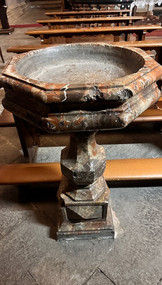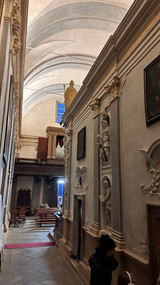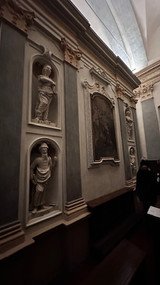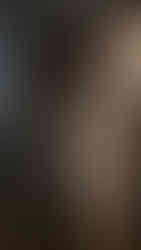Santa Marta Church – Chiesa Santa Marta
- Maria Scuor
- Dec 25, 2024
- 4 min read
Scorri a basso per l’italiano
Santa Marta also known as Saint Maria of Loreto replaced the unsafe and dilapidated fourteenth-century church dedicated to St. Catherine when Margherita Borromeo, mother of Cardinal Federigo and aunt of San Carlo Borromeo commissioned the building to start in 1592. She devoted this true-to-life reproduction to the Holy House of Loreto, which is a Basilica located in Loreto, in the Marche region.
Legend has it that some angels took the small house that the Blessed Virgin Mary lived in, in Nazareth and moved it back and forth from Nazareth to Loreto to keep the house and her safe. The journey of the house of Nazareth towards Loreto is called "translation of the Holy House". In Marche, there is a tradition of lighting large fires (the focaracci or fogaró della Venuta ) on the night between 9 and 10 December to "light the way to the Holy House". The fires of the feast of the Venuta, means the "coming" the arrival of the Holy House. In 1920, Pope Benedict XV decreed March 24th, the celebration for the proclamation of Our Lady of Loreto as "Patroness of Aviators".
Santa Marta church is located in Piazza del Popolo in Arona, facing the ancient port and has stair cases on either side of the portico entry that were built by Francesco Maria Richini in 1646. The church was entrusted in the custody of the Confraternity of Santa Marta and the Holy Trinity in 1650 and continued to be managed by them until dissolution, which occurred some time between the two world wars.
Entering through the one entrance, you find yourself in front of a very high altar where stands the amazing marble statue depicting the Assumption by Marcantonio Prestinari (1613). Cardinal Borromeo brought Marcantonio in from Milan where he was working on statues for the Duomo. The very Baroque (highly decorated style that appeared in Italy in the 17th century) altar, was made in such a way to create colour contrasts with the use of black and white marble. It was designed that way to bring out the whiteness of the Assumption statue.
On the right wall there is a wooden altarpiece depicting the Holy Trinity in glory between a flight of Cherubim. To the left a “Wooden Crucifix and History of the Passion” from the 16th century. All along the perimeter walls there are large well-made paintings. The Casa di Loreto, has niches with a series of sixteen statues, depicting Prophets and Sibyls, dated from the early 18th century.
The only fresco is found inside the Casa di Loreto, and depicts the Madonna and Child flanked by the coat of arms of the Borromeo’s. The painting dates back to the 1520s where it was in a building on the lakefront. It got moved to Casa di Loreto in 1599.
The organ is located in the choir loft above the entrance and is the work of Felice Sivere. It was inserted in 1838 in a brown wooden case with 27 front pipes arranged in 3 cusps. The keyboard has 58 notes and pedalboard 17 notes. The registers are operated by throttles arranged in two columns to the right of the keyboard. The organ doesn’t have an electric fan and works manually through crank inflating system.
Here is a TikTok video and photos of Santa Marta Church - Ecco un video TikTok e le foto della Chiesa di Santa Marta
Chiesa Santa Marta
Santa Marta detta anche Santa Maria di Loreto sostituì l'insicura e fatiscente chiesa trecentesca dedicata a Santa Caterina quando Margherita Borromeo, madre del cardinale Federigo e zia di San Carlo Borromeo ne fece iniziare l'edificio nel 1592. Ha dedicato questa riproduzione realistica alla Santa Casa di Loreto, che è una basilica situata a Loreto, nelle Marche.
La leggenda narra che alcuni angeli presero la piccola casa in cui viveva la Beata Vergine Maria, a Nazareth e la spostarono avanti e indietro da Nazareth a Loreto per tenere al sicuro la casa e Maria. Il viaggio della casa di Nazareth verso Loreto è chiamato "traslazione della Santa Casa". Nelle Marche c'è la tradizione di accendere grandi fuochi (i focaracci o fogaró della Venuta) nella notte tra il 9 e il 10 dicembre per "illuminare la strada verso la Santa Casa". I fuochi della festa della Venuta, significano la "venuta" dell'arrivo della Santa Casa. Nel 1920 papa Benedetto XV decretò il 24 marzo la celebrazione per la proclamazione della Madonna di Loreto a "Patrona degli Aviatori".
La chiesa di Santa Marta si trova in Piazza del Popolo ad Arona, di fronte al porto antico e presenta scale ai lati dell'ingresso del portico che furono costruite da Francesco Maria Richini nel 1646. La chiesa fu affidata alla custodia della Confraternita di Santa Marta e della Santissima Trinità nel 1650 e continuò ad essere gestita da loro fino allo scioglimento, avvenuto a cavallo tra le due guerre mondiali.
Entrando da un unico ingresso, ci si trova di fronte ad un altissimo altare dove si erge la stupefacente statua marmorea raffigurante l'Assunta di Marcantonio Prestinari (1613). Il cardinale Borromeo portò Marcantonio da Milano, dove stava lavorando alle statue per il Duomo. L'altare, molto barocco (stile molto decorato che comparve in Italia nel XVII secolo), è stato realizzato in modo tale da creare contrasti cromatici con l'uso del marmo bianco e nero. È stato progettato in questo modo per far risaltare il candore della statua dell'Assunzione.
Sulla parete destra si trova una pala d'altare lignea raffigurante la Santissima Trinità in gloria tra un volo di Cherubini. A sinistra un "Crocifisso ligneo e Storia della Passione" del XVI secolo. Lungo tutto il muro perimetrale si trovano grandi pitture ben fatte. La Casa di Loreto, presenta nicchie con una serie di sedici statue, raffiguranti Profeti e Sibille, datate agli inizi del XVIII secolo.
L'unico affresco si trova all'interno della Casa di Loreto, e raffigura la Madonna col Bambino affiancata dallo stemma dei Borromeo. Il dipinto risale al 1520 dove si trovava in un edificio sul lungolago. Fu trasferito nella Casa di Loreto nel 1599.
L'organo si trova nella cantoria sopra l'ingresso ed è opera di Felice Sivere. Fu inserito nel 1838 in una cassa di legno marrone con 27 canne anteriori disposte in 3 cuspidi. La tastiera ha 58 note e la pedaliera 17 note. I registri sono azionati da manette disposte in due colonne a destra della tastiera. L'organo non è dotato di elettroventilatore e funziona manualmente tramite un sistema di gonfiaggio a manovella.


















































Comentários